Carl Zeiss 15x60 für ein Blinkgerät
| Für die in den Weltkriegen benutzen Blinkgeräte wurde auch ein 15x60 Doppelfernrohr bzw. Monokular von Zeiss zum Anpeilen und Beobachten gebaut. Die hier abgebildeten Versionen weisen ein Porro II-typisches Prismengehäuse auf. Sie haben einen Schutzdeckel am Objektiv. Für das dritte, graublaue Exemplar wurden vermutlich nachträglich Lederschutzkappen gefertigt. Für die Montage auf dem Stativ bzw. Blinkgerät zeigt das eine Exemplar eine U-förmige Schwalbenschwanzeinrichtung, in die eine kippbare Stativhalterung passte, wie sie beim 2. Modell komplett und beim 3. als Stab zu sehen ist – bei einem weiteren schwarz lackierten Modell ist diese nciht vorhanden. Die Exemplare sind aus Zink oder Aluminium und die beiden ersten schwarz lackiert – das dritte wurde mit einem grau-blauen Lack überzogen. Die Augenmuscheln sind aus Bakelit. Das Okular hat eine umlaufende Dioprienskala (nicht beim 3. Exemplar) und ist von + bis - 8 markiert. |
Zeiss also built 15x60 binoculars and monoculars for the signalling apparatus used in the wars to view and aim at blinking devices. The versions depicted here have a round prism housing typical of porro 2 prism systems. They have lens caps at the objectives. Someone made leather caps for the third specimen. To mount them on a tripod or the signalling apparatus there is a U-shaped slip-on dove-tail bracket. A swivel mount for a tripod could be inserted into the bracket as you can see in photo 3-4 of the 2nd model – the 3rd model comes with a rod and screw hole in that place; another black paitned model has no tripod bracket . Two versions are made of black lacquereed zinc or aluminium, the third was repainted grey-blue. The eye-cups are made of Bakelite. The ocular has a dioptre scale around its tube, marked from + to - 8 (not so at the 3rd model). |
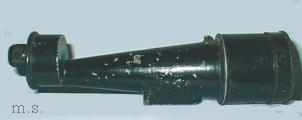
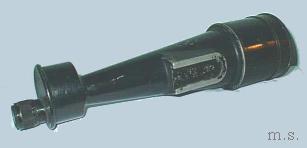
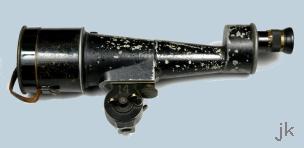
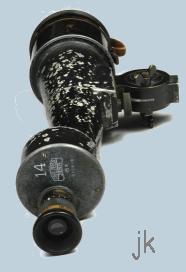
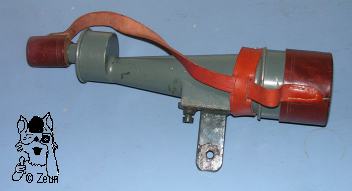
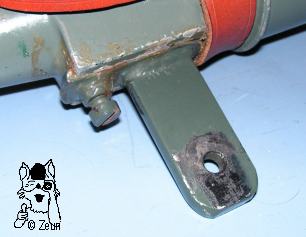
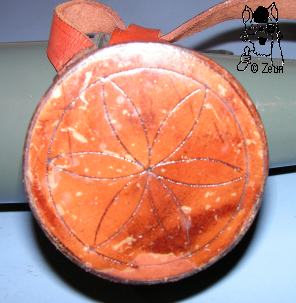
| Das erste 15x60 hat die Seriennummer 641557 (ca. 1916) am oberen Deckel, das zweite 15x60 hat die Seriennummer 310091 (ca. 1912), das dritte mit Seriennummer 641599 (ca. 1916), ein weiteres schwarz lackiertes 362181 (ca. 1913); alle sind mit "15x" sowie dem Zeiss-Logo gekennzeichnet. Die Markierungen mit den Ziffern "2" bzw. "14" und "69" der schwarzen Exemplare stehen wohl für die militärische Gerätenummer, das blaugraue 15x60 ist noch mit "SignalGerät 0365" gekennzeichnet. | The first 15x60 has serial number 641557 (ca. 1916) at the top cover, the second 15x60 serial number 310091 (ca. 1912), and the third serial number 641599 (ca. 1916), and still another one number 362181 (ca. 1913); all are marked "15x" and with the Zeiss lens logo. The numbers 2, 14, and 69 at the prism housing covers of the black painted models are military device numbers; the grey-blue model is also marked "SignalGerät 0365". |
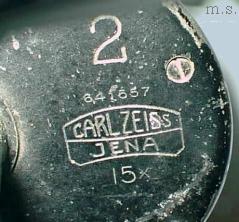
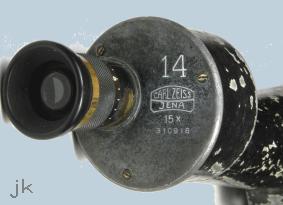
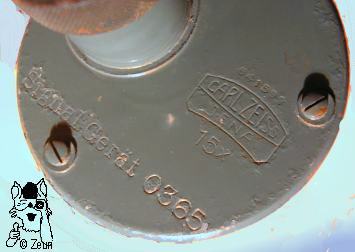
Das 15x60 wiegt 1163g, ist 320-327mm lang, der Durchmesser der Augenmsuchel ist 33mm, des Okulars 27mm, der 35mm hohen Prismendose 58mm. Der 17cm konische Tubus misst 32mm bis 74mm und die 71mm lange gerade Fassung für das Objektiv 77mm im Durchmesser. [Maße des graublauen Exemplars] |
The 15x60 weighs 1163g. It is 320-327mm long, the diameter of the eyecup is 33mm, of the ocular 27mm, of the (35mm long) prism box 58mm. The (17cm long) conical tube measures 32mm to 74mm in diameter, and the (71mm long) straight objective frame 77mm in diameter. [specifications of the grey-blue model] |
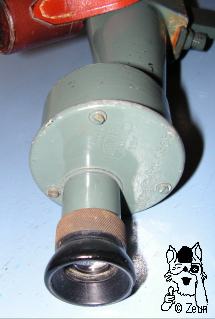
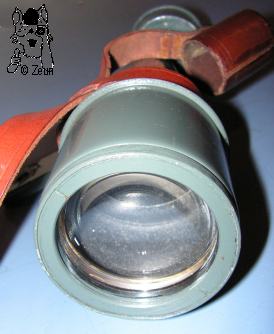
| Das 15x60 wird als "Fernrohr 15x60" in dem Zeiss T834 Büchlein "Das Signalgerät 250mm - S 1914 'F' oder 'p'" (hier: Feb. 1915) beschrieben und seine Funktion erläutert. | The 15x60 named as "Telescope 15x60" was described with its parts and its functions in the Zeiss T834 booklet "Das Signalgerät 250mm - S 1914 'F' oder 'p'" (here: Feb. 1915). |
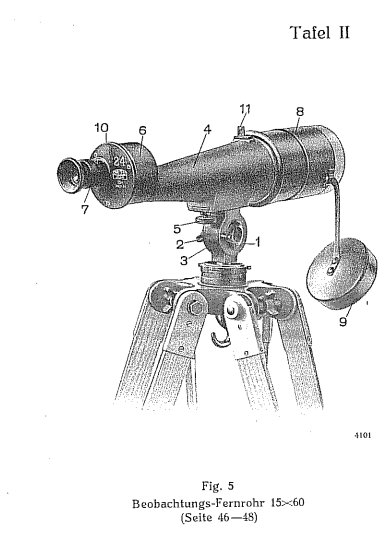
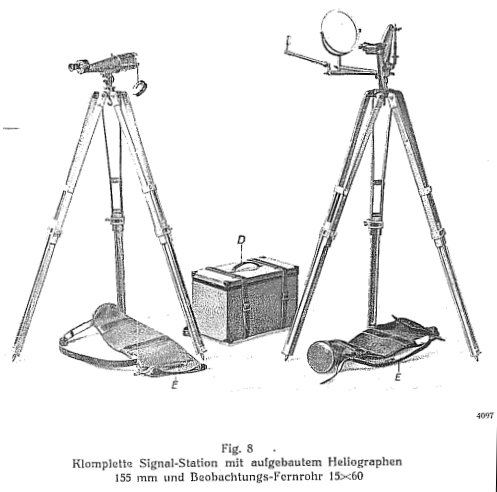
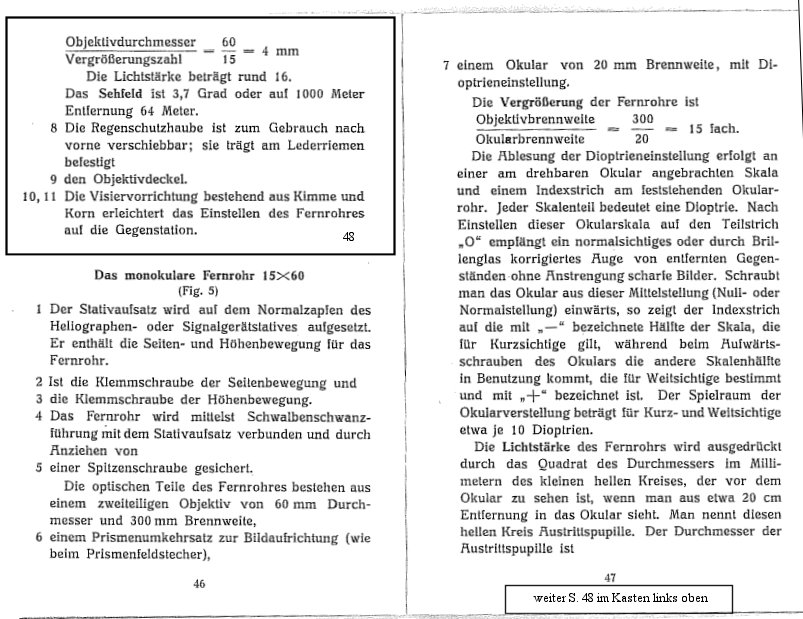
Zeiss Katalog T834 (1915): Tafel I & II, S. 46-48.
| Ein anderes Modell ohne Zeiss-Logo, sondern mit "Carl Zeiss Jena" Lateinischer Druckschrift weist als weitere Besonderheit eine seitlich zum Auge hin klappbare Sonnenblende auf. Diese ist aus schwarz lackiertem Metall und wird mit einer Feder in weggeklappter Position gehalten. Der Prismengehäusedeckel ist außerdem mit Nr. 113 gekennzeichnet. Diese Numemr fidnet sich auch auf dem Schutzdeckel für das Objektiv wieder. Der Deckel hat eine angeschraubte Öse, die wohl zur Befestigung an einem Riemen/Kette zur Sicherung vor Verlust diente. Die Beschriftung in dieser Art taucht bei einigen militärischen Instrumenten von Zeiss auf. Das Okular und die Augenmuschel sind aus Metall. | another model without the Zeiss logo, but with "Carl Zeiss Jena" inscribed in Roman letters also features a rayshade which can be flipped to the side of the viewer'S eye. It is made of black painted metal. When fodled away, it is held by a spring in position. The prism cover plate is also marked with number 113. This number is also inscribed on the protection cap for the objective tube. The cap comes with a screwed-on lug which may have served to secure it against loss when attached to a strap or chain. Insciptions of that kind can be found on some Zeiss military isntruments. The eyecpiecas well as the eyecup are made of brass. |
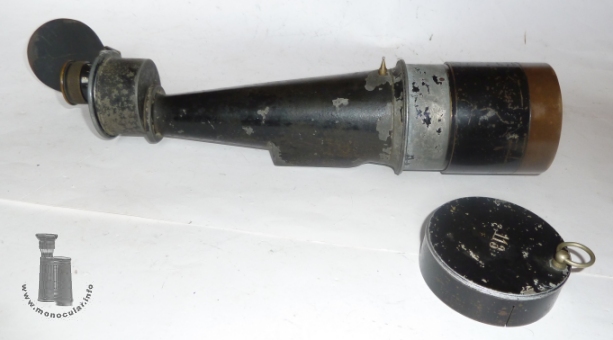
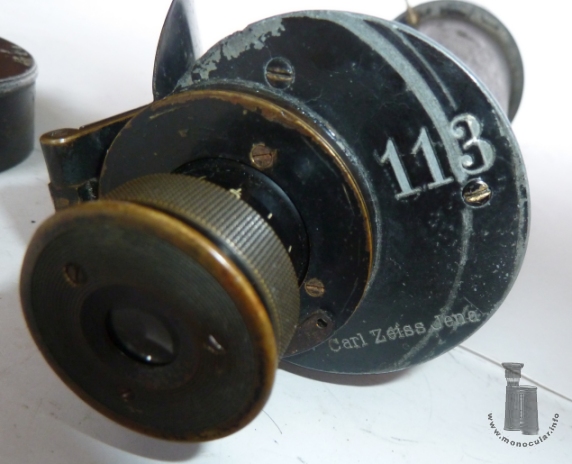
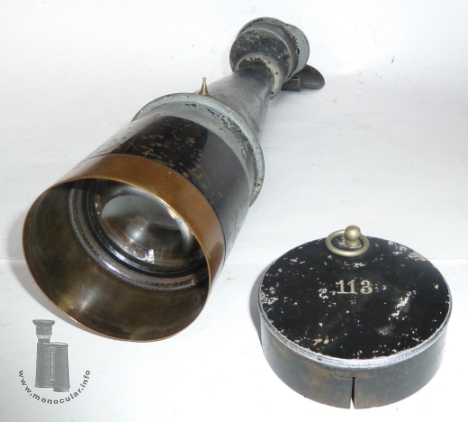
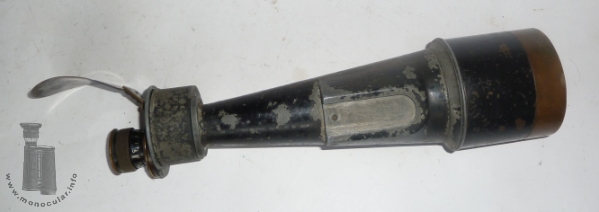
Fotos: M.Simonson; J.Kelly; U. Zeun

